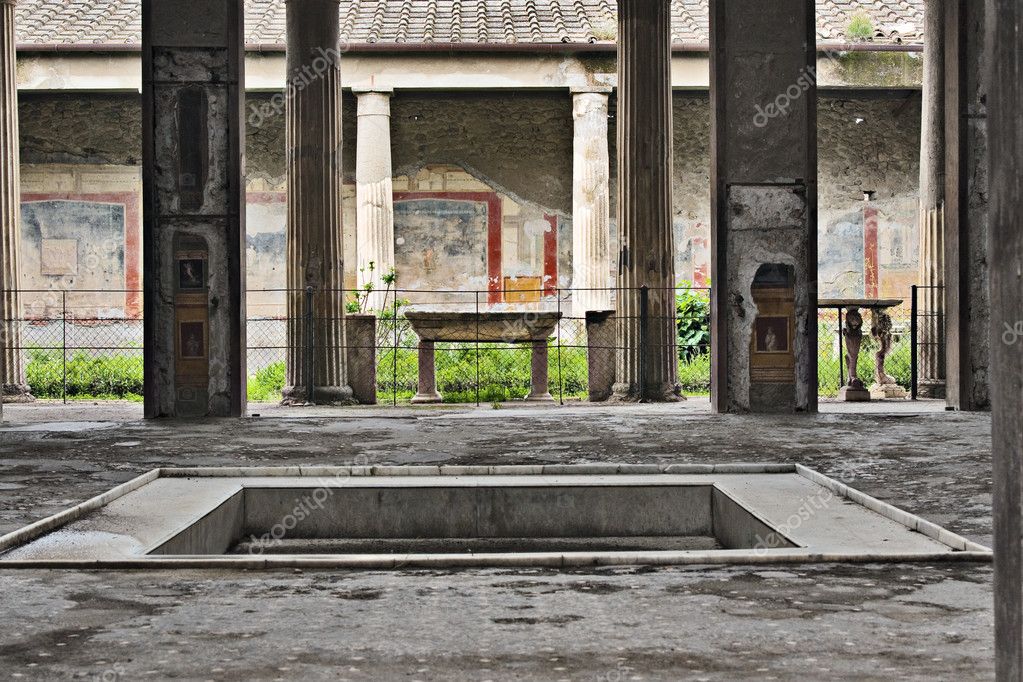Table Of Content
- A Brief History of Scent With Saskia Wilson-Brown
- Join the Lonely Planet community of travelers
- Bedroom ‘used by slaves’ found by archaeologists near Pompeii
- One in seven people admit to using tech to sexually harass colleagues at work, new data shows
- The plan of the house
- Revealing the Risqué Art of Pompeii’s House of the Vettii
- Discover new details
- See inside one of Pompeii's grandest villas as it reopens for the first time in 20 years

The house, built post-earthquake around 62 AD, is a remarkable example of the Second Style of Pompeiian architecture. The dimensions and design of this dwelling indicate an adherence to the classic Roman domus model, with a grand atrium, peristyle garden, triclinium (dining room), and a number of cubicula (bedrooms). The artifacts that were recovered allowed for the identification of the house’s putative owners, Aulus Vettius Conviva and his brother, Aulus Vettius Restitutus. The Vettii had risen to some prominence; Conviva was an augustalis—the top civic office for which a freedman would be eligible. In the construction and decoration of their house the brothers display a mind-set not uncommon among the newly-rich. Two strongboxes (arca—essentially lockable boxes for storing valuables), concrete signs of wealth, were placed prominently in the large atrium so that visitors would be sure to notice them.
A Brief History of Scent With Saskia Wilson-Brown
It stands out as one of the most complex archaeological heritage restoration projects of the last few decades. It has proved particularly difficult to remove the layers of wax applied to the frescoes in the past with the intention of protecting and enhancing them. Unfortunately, this restoration method has proved to be extremely harmful and has obscured many of the details of the elegant paintings, with depictions of fantastic architecture and mythological scenes.
Join the Lonely Planet community of travelers
The women discovered Pentheus, hidden behind a pine tree, but mistook him as a lion. When looking through the main entrance and large atrium, it is possible to view the rear garden, surrounded by the large peristyle. Zuchtriegel ventured that the fresh “readings” of the revived fresco painting “reflect the dreams and imagination and anxieties of the owners because they lived between these images,” which include Greek mythological figures. On Tuesday, the House of Vettii, Domus Vettiorum in Latin, was being formally unveiled after 20 years of restoration. Given fresh life were frescoes from the latest fashion in Pompeii wall decoration before the flourishing city was buried under the volcanic ash furiously spewing from Mount Vesuvius in 79 AD.
Bedroom ‘used by slaves’ found by archaeologists near Pompeii
This luxurious residence houses an impressive collection of Fresco decorations typical of the wall paintings in the houses of rich Pompeian traders. The excavation techniques used made it possible to preserve, in almost all the rooms in the complex, the fourth-style figure paintings completed after the earthquake of 62 A.D.. The more richly decorated rooms overlook the peristylium, including the living room with the frieze of Cupids which carry out the main productive activities of that time, from selling wine to cleaning clothes, cultivating flowers to harvesting, jewellery making to creating perfumes. The lararium painting is found in the kitchen area; a graffiti at the entrance of the house indicates that the prostitute, Eutychus, who was a slave offering herself for two Asses, carried out her affairs in the adjacent room, decorated with a number of erotic paintings. The garden of the peristyle (colonnaded garden), which had a complex system of water channels and small fountains, has been restored with the inclusion of copies of the original statues, including a unique statue of its kind depicting Priapus, the god of fertility.
One in seven people admit to using tech to sexually harass colleagues at work, new data shows
In addition to having part of their names in common, they shared a common past — not as descendants of noble Roman families accustomed to opulence, but rather, Pompeii experts say, almost certainly, as once enslaved men who were later freed. That is delighting tourists and rewarding experts with tantalizing fresh insights into the everyday life of what is one of the most celebrated remnants of the ancient world. The unveiling of the restored home is yet another sign of the rebirth of Pompeii, which followed decades of modern bureaucratic neglect, flooding and pillaging by thieves in search of artifacts to sell. Almost 2,000 years ago, Mount Vesuvius erupted and smothered the Roman town of Pompeii.
The House of Vettii, Domus Vettiorum in Latin, likely belonged to two former slaves who became rich through the wine trade. The new restoration project, which began in 2016 under the direction of Massimo Osanna, has involved a wide range of professionals including archaeologists, architects, restorers, engineers, structural engineers and experts on gardening. Pompeii Arcaeological Park Tickets.Thank you for visiting pompeiiarchaeologicalpark.com. We made an easy to navigate website with links to the most well-known tickets providers so you can buy your tickets with confidence and safety. Its strategic location within the Pompeii Archaeological Park and the preservation of its original decorations make it a must-visit for any history enthusiast. The House of the Vettii truly stands as a testament to the societal norms, aesthetic sensibilities, and creative craftsmanship of the affluent Romans in Pompeii.
Revealing the Risqué Art of Pompeii’s House of the Vettii
The interior walls were adorned with sumptuous frescoes, and the floors were often decorated with delicate mosaics, both executed by skilled craftsmen of the era. Erotic art has been turning up at Pompeii since excavations began in the 18th century. At first, the naughtier pieces would be spirited off to the Gabinetto Segreto (Secret Cabinet) in Naples, away from the innocent eyes of the general public. The House of Vettii, however, was one of the first sites to be unearthed using modern archeological techniques, and its artifacts were left in situ so their context could be preserved for future scholars and the public.
Discover new details
Much of their exuberant decor survives today, including a garden featuring statues and a fountain as well as a number of lavish, sometimes erotic, frescoes. One such fresco, located at the home’s entrance, features Priapus, the Greek god of fertility, with a large phallus balancing on a scale along with a bag of money. More erotic frescoes are contained in a small room that researchers think may have been used as a brothel. The Peristyle is decorated with black panelling with alternate still life and figure paintings.

See inside one of Pompeii's grandest villas as it reopens for the first time in 20 years
However they knew each other, Aulus Vettius Conviva and Aulus Vettius Restitutus may have met the same fate as thousands of others living in Pompeii at the time. As HISTORY reports, an estimated 2,000 people died in Pompeii following the eruption of Mount Vesuvius in 79 C.E., which likely killed around 16,000 people in the towns and villages nearby. Marco Cantile/LightRocket via Getty ImagesElaborate frescoes line the walls in the House of the Vettii.
This scene depicts King Minos's wife, Pasiphae, and the craftsman Daedalus, whom Pasiphae ordered to construct a cow so she could sleep with her husbands treasured bull. Her lust towards the bull was a consequence of King Minos refusing to sacrifice the bull to Poseidon, angering the god who punished King Minos by making Pasiphae lust after the bull. Daedalus and his son Icarus were punished through imprisonment by King Minos for his assistance, leading into the famous myth of a winged escape from Crete. This mythological scene is located on the east wall of the north triclinium, which is located next to the large peristyle.
Tucked within the heart of the illustrious Pompeii Archaeological Park, stands the House of the Vettii, a captivating testament to the sophistication and grandeur of ancient Roman life. A rare survivor of the catastrophic eruption of Mount Vesuvius in 79 AD, this residential structure offers invaluable insights into the architectural prowess, artistic sensibilities, and daily routines of its former inhabitants. Beginning with the Renaissance interest in all things classical, architectural historians and archaeologists have been debating the form and function of ancient Roman houses for several hundred years. The interest in the domestic architectural form was fueled further by the re-discovery, in the middle of the eighteenth century, of Pompeii, Herculaneum, and other sites destroyed by Vesuvius. Buried by a volcanic eruption two thousand years ago, this Roman house was the epitome of wealth and style. On Tuesday, officials unveiled the newly restored home, welcoming tourists to observe the ancient architecture and elegant frescoes.
The rooms laid out on the left of the entrance hall are decorated with mythological subjects, which are described below. “The House of the Vetti is like the history of Pompeii and actually of Roman society within one house,” Pompeii’s director, Gabriel Zuchtriegel, gushed as he showed off an area of the domus known as the Cupid Rooms last month. "But it is also a story about the social life of the Pompeiian society and actually the Roman world in this phase of history."
Which doesn’t mean the Victorian-era archeologists weren’t still scandalized by what they found. According to an 1896 edition of The English Illustrated Magazine, a House of the Vettii painting “only suitable to that barbarous period of Europe’s history [was] very properly… covered over” before the dig continued. Overall the evidence furnished by the House of the Vettii offers key insights into domestic architecture and interior decoration in the last days of the city of Pompeii.
Revealing the Risqué Art of Pompeii's House of the Vettii - Atlas Obscura
Revealing the Risqué Art of Pompeii's House of the Vettii.
Posted: Tue, 07 Feb 2023 08:00:00 GMT [source]
"We're seeing here the last phase of the Pompeian wall painting with incredible details, so you can stand before these images for hours and still discover new details," he added ahead of Tuesday's reopening. Another room, near the kitchen, is decorated with graphic erotic wall art and archaeologists believe this room would have been used as a brothel, something that was common in the homes of the elite at the time, as prostitution was permitted both socially and legally in Pompeii. Although the images depicted on the walls of the brothels are often sensual and alluring, the sex workers of Pompeii were enslaved people. In addition to the Cupid Rooms, visitors will see bronze and marble statues inside the home, planted gardens, marble fountains, and walls and walls of extravagant art depicting sacrifices, hunts, erotic scenes and Greek mythology.

No comments:
Post a Comment